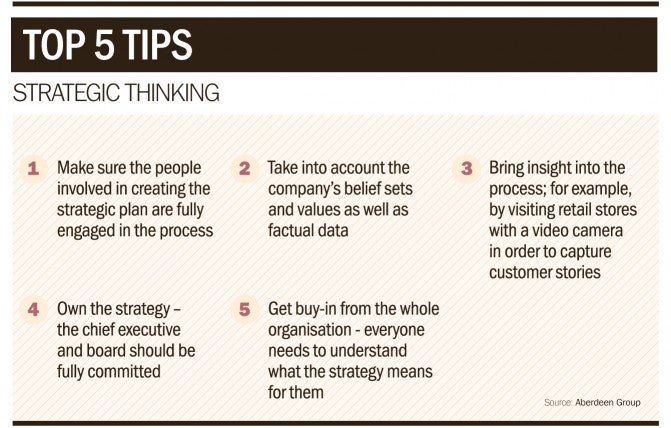Having a defined business strategy and plan is crucial for every company, from startups to multinational corporations. In order to grow the business, the board, employees and relevant stakeholders need to understand what the company is trying to achieve, and how it plans to get there.
A strategic plan sets out these objectives in a consistent way. Typically the plan will include the company’s mission statement and goals, as well as details of target customers and the key performance indicators that will be used to measure success.
Other essential components include financial projections, an operational plan and analysis of the industry in which the company operates. From the strategic plan, the company can then create a business plan which sets out how the company will achieve its strategic goals.
Established companies rarely create a business strategy from scratch; the strategy is usually drawn up when the business is first set up. However, the strategy needs to be reviewed regularly to make sure it remains relevant to market conditions and the company’s capabilities.
“Strategy should only be written seriously every three years,” says Allan Gasson, strategy partner at Deloitte. “You can’t change organisations fast enough to merit rewriting strategy from scratch more often than that.”
Companies typically write a five-year vision statement, which is used as the basis for a three-year strategy. This is then used to generate a one-year business plan, he says.
Other triggers may prompt this strategy to be reviewed or refined, such as market disruptions, regulatory changes or concerns regarding the company’s performance compared to its competitors. A change in chief executive or a new acquisition could also prompt a strategic review.
PROCESS
Rob Law, chief executive of children’s travel products company Magmatic, which produces the Trunki brand, says there are always ideas bubbling over within the business that are brought up in monthly senior management meetings or even at board level. “But once a year we go through workshops with the team to identify the new goals for the year, which forms a micro strategy,” he says. “That process is captured on a bit of software that we review once a quarter.”
Any sizeable organisation will include input from multiple sources when creating or refining its strategy document. Jacqueline Windsor, strategy partner at PwC, says two groups of people should be involved: those who shape the strategy and those who provide insights. “The group actually doing the strategy is a smaller group – it doesn’t have to be the top team per se, but the leadership team that represents different parts of the business,” she says. “Clearly this will include the CEO, but companies should also include multiple lenses: customer, trading, supply chain/logistics and financial.”
The strategy needs to be reviewed regularly to make sure it remains relevant to market conditions and the company’s capabilities
Developments in technology are making it more feasible for geographically dispersed teams to work together remotely. “We use various online applications where people around the world can input information using their iPads,” says Mr Gasson. “You can do that so quickly, with people in Australia and New York coming together, and then you can collectively look at the results and start building a consensus around what the strategy is and what needs to be done.”
For other companies, having everyone in the same room is essential to the strategy-building process. Some spread the process out with a series of workshops over the space of a couple of months, while others opt for a more intensive approach.
Estelle Rowe, director of Dot Dot Consultancy, says some companies might seek “splendid isolation” and lock themselves away for a week, although she points out that, if the process is too stifling, tensions can arise. “It’s important to introduce an element of space so that people can take time to think about what they’ve heard,” she adds.
Meanwhile, Emma Warren, managing director of business advisory firm Portfolio Directors, advocates an “open and closed gate” process. “You open it out, data gather, close the gate and bring it all back in,” she says. “You can then draw some conclusions and share the next stage with everybody in order to get their feedback.”
NEXT STEPS
Having a consistent and informative strategy document is important, but equally important is what you do with it next. There’s little point in creating a strategy which is going to sit on a shelf gathering dust for the next year.
As well as feeding into the business plan, the strategy needs to be communicated to the management team and filtered down to everyone in the organisation so that everyone understands their role in helping the company achieve its strategic goals. This is illustrated by the story of the NASA cleaner who reportedly told President John Kennedy, “My job is to help put a man on the moon”.
Not everyone will receive the full strategy document – different sections may be circulated to different people, depending on their job function or relationship to the company – but all communications should present a consistent story. “How you communicate it can vary depending on the audience, but ultimately everyone needs to be telling the same story and singing from the same hymn sheet,” PwC’s Ms Windsor concludes.
PROCESS

